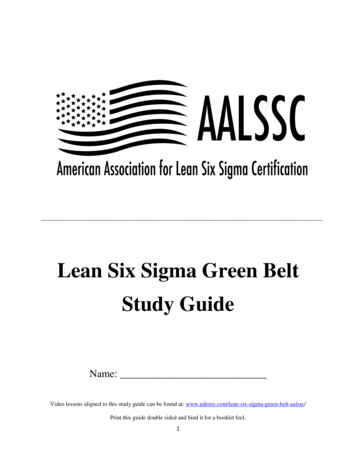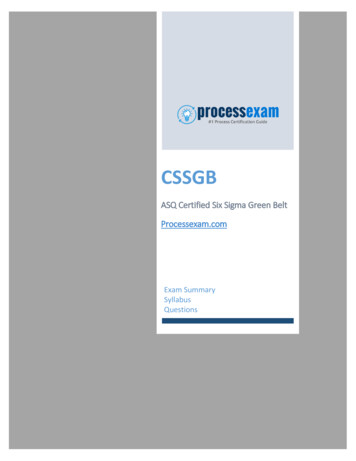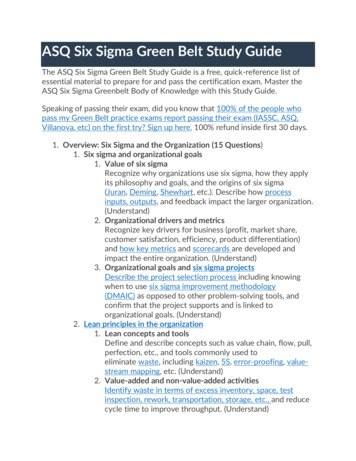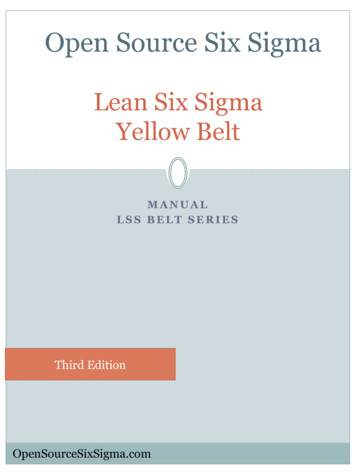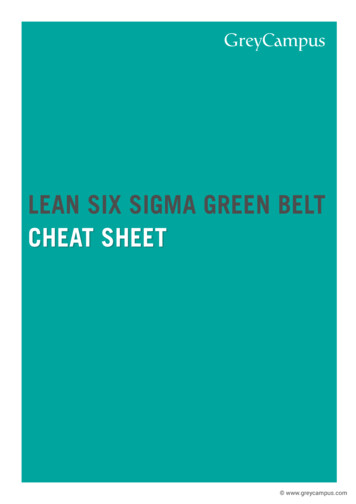
Transcription
GreyCampusLEAN SIX SIGMA GREEN BELTCHEAT SHEET www.greycampus.com
2Includes formulas: what they are, when to use them, referencesCONTENTSLEAN CONCEPTS VSM Value Stream MappingTAKT TimeBatch SizeSMED Singe Minute Exchange of DieTheory of ConstraintsTPM Total Productive MaintenanceSAMPLING Sample Size CalculatorSingle lot SamplingDual lot SamplingContinuous SamplingStratified SamplingRandom SamplingMSA MSA Measurement System AnalysisKappa MSADATA ANALYSIS Statistics Error TypesHypothesis TestingPearson Correlation Co-efficientCentral Limit TheoremFMEA Failure Mode and Effects AnalysisPROCESS CONTROL Attribute vs. Variable DataControl ChartsVOC Voice Of the CustomerControl LimitsProcess CapabilityControl plan www.greycampus.com
3LEAN CONCEPTSVSM Value Stream Mapping Value Stream Mapping is a tool used to understand a process and how muchvalue-added and non-value added time is spent on and between each activity.The VSM will include a data box of key statistics, such as:Data BoxCurrent StateFuture State% ImprovementValue Add TimeNon Value Add TimeLead TimePeopleSystemsSystem TouchesInventoryTAKT Time Often referred to as the rate of customer demand.It is how often a product needs to be completed to meet customer demand.Formula Effective Working Time / Average Customer Demand (for that timeperiod)Batch Size To keep this explanation lean I’ll just write that moving to batch sizes of onegenerally reduces cycle time and improves throughput.SMED Singe Minute Exchange of Die SMED stands for Single Minute Exchange of Die, and covers the techniquesfor obtaining a changeover time of less than 10 minutes (a single digit number of minutes).Basically, the SMED methodology consists of 6 steps: observe the current changeover processidentify internal and external activitiesconvert activities from internal to external setupincrease efficiency of the remaining internal activitiesoptimize the Startup timeincrease efficiency of external activitiesTheory of Constraints The underlying assumption of Theory of Constraints is that organizations canbe measured and controlled by variations on three measures: Throughput,Operating Expense, and Inventory. www.greycampus.com
4 Throughput is money (or goal units) generated through sales. Operating Expense is money that goes into the system to ensure its operation on an ongoing basis. Inventory is money the system invests in order to sell its goodsand services.Theory of Constraints is based on the premise that the rate of goal achievement is limited by at least one constraining process. Only by increasing flowthrough the constraint can overall throughput be increased. Assuming thegoal of the organization has been articulated (e.g.,“Make money now and inthe future”) the steps are:1. IDENTIFY the constraint (the resource/policy that prevents the organization from obtaining more of the goal)2. Decide how to EXPLOIT the constraint (make sure the constraint’s time isnot wasted doing things that it should not do)3. SUBORDINATE all other processes to above decision (align the whole system/organization to support the decision made above)4. ELEVATE the constraint (if required/possible, permanently increase capacity of the constraint; “buy more”)5. If, as a result of these steps, the constraint has moved, return to Step 1.Don’t let inertia become the constraint.TPM Total Productive Maintenance TPM is a program for planning and achieving minimal machine downtimeEquipment and tools are literally put on “proactive” maintenance schedulesto keep them running efficiently and with greatly reduced downtimeMachine operators take far greater responsibility for their machine upkeepMaintenance technicians are liberated from mundane, routine maintenance,enabling them to focus on urgent repairs and proactive maintenance activitiesA solid TPM program allows you to plan your downtime and keep breakdowns to a minimumWithout a strong TPM program, becoming truly Lean would be difficult orimpossible in an environment heavily dependent on machineryBuy-in at the shop floor level is generally quite high as TPM is an excitingundertakingA robust TPM system consists of: Autonomous MaintenanceFocused ImprovementEducation and TrainingPlanned MaintenanceQuality MaintenanceEarly Management and Initial Flow ControlSafety, Hygiene and Pollution ControlAdministrative and Office TPM www.greycampus.com
5 The metric used in Total Productive Maintenance environments is called OEEor Overall Equipment Effectiveness OOE is measured as a percentage OOE Availability * Performance * Quality Availability % of scheduled production equipment is available forproductionPerformance % number of parts produced out of best known production rateQuality % of good sellable parts out of total parts producedSAMPLINGSample Size Calculator To determine how large a sample you need to come to a conclusion about apopulation at a given confidence level.Formula for creating a sample size to test a proportion: no {Z2 pq}/{e2} no required sample size Z value from the Z table (found on-line or in stats books) forconfidence level desired p estimated proportion of population that has the attributewe are testing for q 1-p e precision {ie: if we want our proportion to be known within10% then set ‘e’ at .05 and if we set the confidence interval at95% and the sample gives a proportion of 43%, the true value at95% confidence is between 38% and 48%}Formula for creating a sample size to test a mean: no required sample sizeZ value from the Z table (found on-line or in stats books) forconfidence level desired σ variance of the attribute in the population e precision in the same unit of measure as the varianceSingle lot Sampling Single lot sampling is when your sample comes from a single lot. It is oftenused in manufacturing when output from a single lot is sampled for testing.This may be used as a Lot Acceptance Sampling Plan (LASP) to determinewhether or not to accept the lot: www.greycampus.com
6 Single sampling plans: One sample of items is selected at random froma lot and the disposition of the lot is determined from the resultinginformation. These plans are usually denoted as (n,c) plans for a sample size n, where the lot is rejected if there are more than c defectives.These are the most common (and easiest) plans to use although notthe most efficient in terms of average number of samples needed.Dual lot Sampling Dual lot sampling is when your sample comes from 2 different but similarlots. It is often used as part of an MSA or as part of hypothesis testing to determine if there are differences in the lots.Continuous Sampling Continuous sampling is used for the inspection of products that are not inbatches. The inspection is done on the production line itself, and each inspected item is tagged conforming or non-conforming. This procedure canalso be employed to a sequence of batches, rather than to a sequence ofitems (known as Skip Lot Sampling).Stratified Sampling Stratified Sampling is when the population is dived into non-overlappingsubgroups or strata and a random sample is taken from each subgroup. It isoften used in hypothesis testing to determine differences in subgroups.Random Sampling Random sampling is a sampling technique where we select a group of subjects (a sample) for study from a larger group (a population). Each individual is chosen entirely by chance and each member of the population has aknown, but possibly non-equal, chance of being included in the sample.MSAMSA Measurement System Analysis A Measurement System Analysis, abbreviated MSA, is a specially designedexperimentthat seeks to identify the components of variation in the measurement.Since analysis of data is key to lean six sigma ensuring your data is accurateis critical. That’s what MSA does – it tests the measurements used to collectyour data.Common tools and techniques of Measurement Systems Analysis include:calibration studies, fixed effect ANOVA, components of variance, AttributeGage Study, Gage R&R, ANOVA Gage R&R, Destructive Testing Analysis andothers. The tool selected is usually determined by characteristics of the measurement system itself. Gage R & R ANOVA Gauge R&R measures the amount of variability induced in measurements that comes from the measurement www.greycampus.com
7system itself and compares it to the total variability observedto determine the viability of the measurement system. There are two important aspects on a Gauge R&R: Repeatability, Repeatability is the variation in measurements taken by a single person or instrument on the sameitem and under the same conditions. Reproducibility, the variability induced by the operators.It is the variation induced when different operators (ordifferent laboratories) measure the same part. Formulas (this is best done using a tool such as Minitab orJMP): yijk μ αi βj αβij εijkYijk observation k with part i& operator jμ population meanαi adjustment for part iβj adjustment for operator jαβij adjustment for part i operator j interactionεijk observation random ‘error’ σ2y σ2i σ2j σ2ij σ2error σ2y Variance of observation yσ2i Variance due to part iσ2j Variance due to operator jσ2ij Variance due to part I operator j interactionσ2error Variance of that observation due to ran-dom ‘error’These formulas are used in the ANOVA Gage R &R to determine repeatability & reproducibility.Kappa MSA MSA analysis for discrete or attribute data. Kappa (K) is defined as the proportion of agreement between ratersafter agreement by chance has been removed. K {Pobserved – Pchance}/{1 – Pchance} Pobserved proportion of units classified in which the raters agreedPchance proportion of units for which one would expect agreementbychance Generally a K .7 indicates measurement system needs improvement K .9 are considered excellent www.greycampus.com
8DATA ANALYSISStatistics Error Types Type 1, Alpha or α errors Type I error, also known as an “error of the first kind”, an α error, or a“falsepositive”: the error of rejecting a null hypothesis when it is actuallytrue. Plainly speaking, it occurs when we are observing a difference whenin truth there is none. An example of this would be if a test shows that awoman is pregnant when in reality she is not. Type I error can be viewedas the error of excessive credulity.Type 2, Beta or β errors Type II error, also known as an “error of the second kind”, a β error, or a“false negative”: the error of failing to reject a null hypothesis when it isin fact not true. In other words, this is the error of failing to observe adifference when in truth there is one. An example of this would be if atest shows that a woman is not pregnant when in reality she is. Type IIerror can be viewed as the error of excessive skepticism.Hypothesis Testing When to use what test: (The Six Sigma Memory Jogger II p 144) If comparing a group to a specific value use a 1-sample t-test (The LeanSix Sigma Pocket Toolbook p 162) Tells us if a statistical parameter (average, standard deviation, etc.)is different from a value of interest. Hypothesis takes the form Ho: µ a target or known value This is best calculated using a template or software package. Ifneeded the formula can be found in the reference. If comparing 2 independent group averages use a 2-sample t-test (TheLean Six Sigma Pocket Toolbook p 163) Used to determine if the means of 2 samples are the same. Hypothesis takes the form Ho: µ1 µ2 If comparing 2 group averages with matched data use Paired t-test The number of points in each data set must be the same, and theymust be organized in pairs, in which there is a definite relationshipbetween each pair of data points If the data were taken as random samples, you must use the independent test even if the number of data points in each set is thesame Even if data are related in pairs, sometimes the paired t is still inappropriate Here’s a simple rule to determine if the paired t must not be used- if a given data point in group one could be paired with any datapoint in group two, you cannot use a paired t test www.greycampus.com
9 If comparing multiple groups use ANOVA (The Lean Six Sigma PocketToolbook p 173) Hypothesis takes the form Ho: µ1 µ2 µ3 The smaller the p-value the more likely the groups are different.Pearson Correlation Co-efficient In statistics, the Pearson product-moment correlation coefficient (sometimesreferred to as the PMCC, and typically denoted by r) is a measure of the correlation (linear dependence) between two variables X and Y, giving a valuebetween 1 and 1 inclusive. It is widely used in the sciences as a measure ofthe strength of linear dependence between two variables. Remember Pearson measures correlation not causation. A value of 1 implies that a linear equation describes the relationship betweenX and Y perfectly, with all data points lying on a line for which Y increases asX increases. A value of 1 implies that all data points lie on a line for which Ydecreases as X increases. A value of 0 implies that there is no linear relationship between the variables. The statistic is defined as the sum of the products of the standard scores ofthe two measures divided by the degrees of freedom Based on a sample ofpaired data (Xi, Yi), the sample Pearson correlation coefficient can be calculated as: r {1/(n-1)} [(Xi – X(avg))/(Sx)][(Yi-Y(avg))/(Sy)] where n sample size Xi the value of observation I in the X plane X(avg) the average X value Sx the standard deviation of X Yi the value of observation i in the Y plane Y(avg) the average Y value Sy the standard deviation of YCentral Limit Theorem In probability theory, the central limit theorem (CLT) states conditions underwhich the sum of a sufficiently large number of independent random variables, each with finite
jects (a sample) for study from a larger group (a population). Each individ-ual is chosen entirely by chance and each member of the population has a known, but possibly non-equal, chance of being included in the sample. A Measurement System Analysis, abbreviated MSA, is a specially designed

